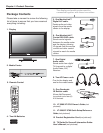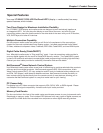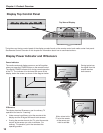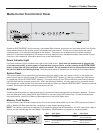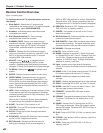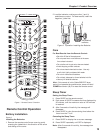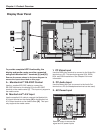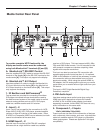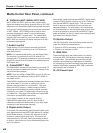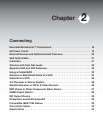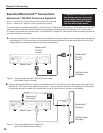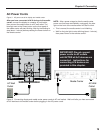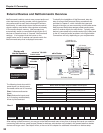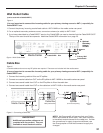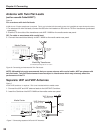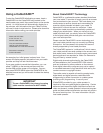
Chapter 1: Product Overview
16
Media Center Rear Panel, continued
6. Antenna (ANT-1 MAIN, ANT-2 AUX)
ANT-1 MAIN and ANT-2 AUX can each receive both
digital and analog over-the-air channels from a VHF/UHF
antenna or non-scrambled digital/analog cable channels.
Your primary viewing signal source should be connected
to ANT-1 MAIN. ANT-1 MAIN must be used to view
premium subscription cable TV service authorized
by the CableCARD™ access card. The CableCARD
access card is provided by your local cable company.
ANT-2 AUX can continue to receive over-the-air or non-
scrambled cable signals.
7. Audio Line Out
These analog L/R audio output terminals provide an
additional
option for connecting to an A/V Receiver or
other audio device.
NOTE: For the best audio quality, use the Digital Audio
Out terminal if supported by your A/V receiver. For
analog audio, it is generally preferable to connect directly
to the A/V receiver from the cable box, statellite receiver,
DVD player, etc.
8. CableCARD™ Slot
The CableCARD access card provided by your cable TV
service provider is inserted into this slot. The top of the
card should face upwards.
NOTE: If you are using a CableCARD, be sure to connect
the cable from the cable wall outlet to ANT-1 MAIN on
the media center.
CableCARD is a nationwide standard system that allows
your local cable TV provider to supply you with an
access card customized to your account. This card
allows the HDTV (display + media center) to receive,
decode and unscramble the premium digital channels
included in your cable TV subscription without the use
of a cable box. See page 23 for additional CableCARD
information and activation instructions.
If your cable company is not currently offering
CableCARD access cards, you will need to use a
cable box provided and authorized by your local cable
company to view scrambled channels.
9. Digital Audio Output
This output will automatically send Dolby® Digital audio
from digital channels and IEEE 1394 devices to a digital
Audio/Video receiver. Connect this output to the A/V
receiver’s coaxial digital audio input. The output will
automatically turn off when viewing an analog channel
or device. Use Audio Line Out to send analog sound to
your A/V receiver.
Some digital cable channels send MPEG-1 digital audio
instead of Dolby Digital, however, not all A/V receivers
can decode MPEG-1 digital audio. This can cause
the A/V receivers to produce a loud noise that can
damage speakers. For this reason, the media center
will automatically turn off the digital audio output when
tuned to a channel or device that has MPEG-1 digital
audio and send it to the A/V receiver as analog left and
right audio from Monitor Output.
10. Monitor Output
Use this Composite video and analog audio outputs
under the following circumstances:
• Output to VCR for recording, or other A/V device.
• Output to an auxilliary monitor.
11. IEEE 1394
These terminals allow the media center to connect
to external IEEE 1394 digital products by means of
a single cable. Two terminals are provided for this
purpose, which allow for a high degree of flexibility
for connecting your NetCommand controlled system.
Detailed information regarding IEEE 1394 connection
requirements are in Chapter 4.
12. AC Power Input



